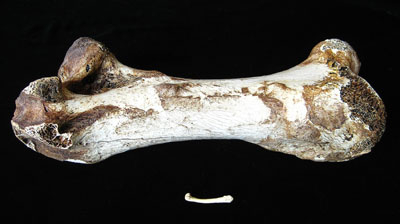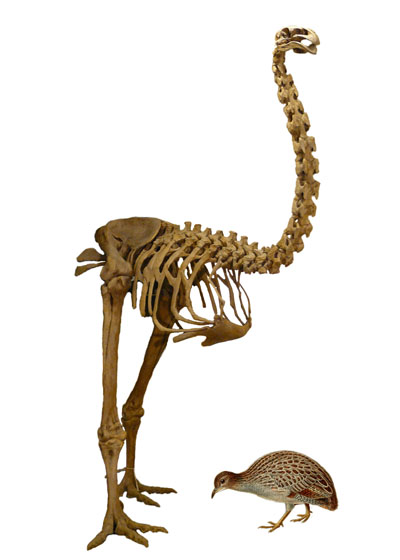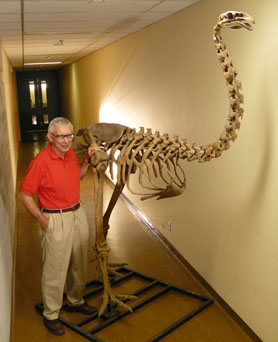DNA confirms relationship between the giant flightless moa and the tinamous

Bringing a historical debate into the genomic age
Why did the ratite cross the supercontinent? The beginning of a joke or part of one of the longest running debates in ornithology (the study of birds)? The large flightless birds known as the ratites currently include the ostrich from Africa, rheas from South America, emu and cassowary from Australia and kiwi from New Zealand. This group also included some recently extinct forms, some of whom were true giants, the moa of New Zealand which reached up to 3.7 m in height and the elephant birds of Madagascar which could weigh an estimated 450 kg.
Many different aspects of the biology of this group sparked debate over the last century and a half. Their flightless condition was attributed by Charles Darwin to wing reduction over time due to lack of use, while his rival Sir Richard Owen believed flightlessness was the result of the retention of juvenile traits into adulthood, a phenomenon known as neoteny. A third hypothesis, which never achieved widespread acceptance, was that the ratites represented an early branch in the evolution of modern birds that split off before the origin of flight. Even the question of whether the ratites formed a natural group, in that they are each other’s closest relatives, was debated. The debate on ratite relatedness was in part fuelled by the group’s widespread distribution, with at least one species of ratite on every major landmass in the southern hemisphere with the exception of Antarctica. There seemed to be no way to explain how these flightless birds on landmasses separated by thousands of kilometres of ocean could be closely related. Instead, it was widely believed that they had evolved from birds in different families who independently lost the power of flight and evolved similar traits as they adapted to similar lifestyles, something known as convergent evolution.
The idea that the ratite birds had independent origins became the dominant view among scientists for the first half of the twentieth century despite some evidence to the contrary, such as a unique arrangement of the palatal bones which only the ratites and tinamous share. This view began to change in the 1960s and early 1970s with a convergence of discoveries and new analyses which lead to a reassessment of the ratites. New molecular techniques used to examine evolutionary relationships revealed that within birds, the ratites and tinamous were in fact each others’ closest relatives. The acceptance of plate tectonics and continental drift provided an explanation of how these flightless birds might have gained such a wide discontinuous distribution, as every landmass where a ratite is found was once joined together and formed a supercontinent known as Gondwana. Based upon this evidence, a new theory was proposed that the ratites likely descended from a common ancestor that had lost the power of flight on Gondwana, and as the supercontinent broke up, the ancestral ratites became separated as they rafted away on their continental fragments and evolved in isolation. This view became so dominant that the ratites were often used in textbooks as an example of how life and evolution has been shaped by continental drift.
In the 1990s, DNA sequences from different ratite and tinamou species were compared for the first time. Initially single genes were examined and it became evident that the timing of divergences between ratite species did not match up with the timing of when the landmass they occupy broke away from Gondwana in all cases. Theories began to be formulated to compensate for this, that their current distribution must have been a product of both continental drift and some form of dispersal. What complicated the story further was that a single gene or a few genes were not providing enough evidence for clearly resolving the relationships between the ratites themselves. There was even some suggestion that the tinamous may be more closely related to some ratite species than these species were to other ratites. This suggestion gained strong support when multiple nuclear gene sequences were examined. Placing the tinamous, who can fly, nested within the tree of flightless ratites changes the interpretation of their evolution. In evolution traits are far more easily lost than acquired. There are many examples of the ability to fly being lost in different bird species but no examples of flight being acquired in a flightless bird species (with the exception of the origin of flight). If the tinamous are embedded in the ratite tree then it would seem that their common ancestor likely was a flying bird and flight was then lost independently in the different ratite species. If the ancestral ratites could fly then oceans no longer pose as much of a barrier, thus reducing the influence continental drift would have on shaping the geographic distribution of the ratites and tinamous.

To address whether the tinamou birds really reside inside the ratite heriditary tree and are closely allied with moa, as small numbers of nuclear genes and the reanalysis of mitochondrial genomes suggested, we proceeded to sequence the largest number of genes that has been done for this group. The team looking at this question included me, Dr. Allan J. Baker, Senior Curator of Ornithology and Head, Department of Natural History, and ancient DNA expert Oliver Haddrath, Technician (Ornithology); John McPherson, Ontario Institute of Cancer Research in Toronto and Alison Cloutier, Postdoctoral Fellow, University of Toronto.
For our research, almost a million base pairs of sequence taken from over 1400 genetic loci were collected, as well as eight rare genomic changes shared exclusively by moa and tinamous. The evidence overwhelmingly supports tinamous as the closest living relative to the moa with both being embedded within the ratite tree. This result is remarkable as prior to DNA analysis, no one had ever speculated about such a relationship. The majority of morphological (structural features) studies had always concluded that the ratites form a single group of species who are each other’s closest relatives, and with tinamous their distant relative. There were a few morphological studies which concluded that the tinamous may be nested within the ratites but none suggested the moa-tinamous relationship. This finding reinforces the point that similar traits in different organisms do not always imply that these traits are shared through common ancestry. In size and structure the moa share many traits with the other ratites and this is likely because they all have evolved a similar cursorial lifestyle. Yet the DNA evidence clearly shows that the moa, tallest of the ratites, with species that could weigh up to 250 kg and all completely lacking wings are close relatives to the much smaller flying tinamous weighing less than one kilogram. It remains to be seen if Darwin and Owen were both right – moa lost their wings because of lack of use, versus from alterations in hormone levels that influence wing formation, as has been demonstrated in chick embryos, or both.

The result of our research was published in the science journal Molecular Biology and Evolution, article “Genomic support for a moa-tinamou clade and adaptive morphological convergence in flightless ratites” which was published on May 13, 2014.
Links
Allan Baker’s ROM staff webpage
Oliver Haddrath’s ROM staff webpage
ROM video podcast of Oliver Haddrath discussing the genetic relationship of large flightless birds (third episode of three)
To learn more about DNA see the Kahn Academy YouTube video lesson Introductory DNA
Read more about the historical debate about ratites in the Scientific American blog post "Controversies from the world of ratite and tinamou evolution (part I)"
This research discovery was covered by several news outlets, below are a few news highlights.
National Geographic Daily News
Why Fly? Flightless Bird Mystery Solved, Say Evolutionary Scientists
The New Zealand Herald
Moa more closely related to South American flying bird than kiwi
The Conversation
Study explores evolution of flightless birds

